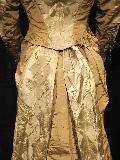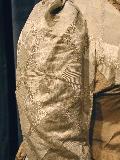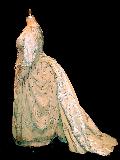Figure 1: Bodice Front |
Figure 2: Bodice Back |
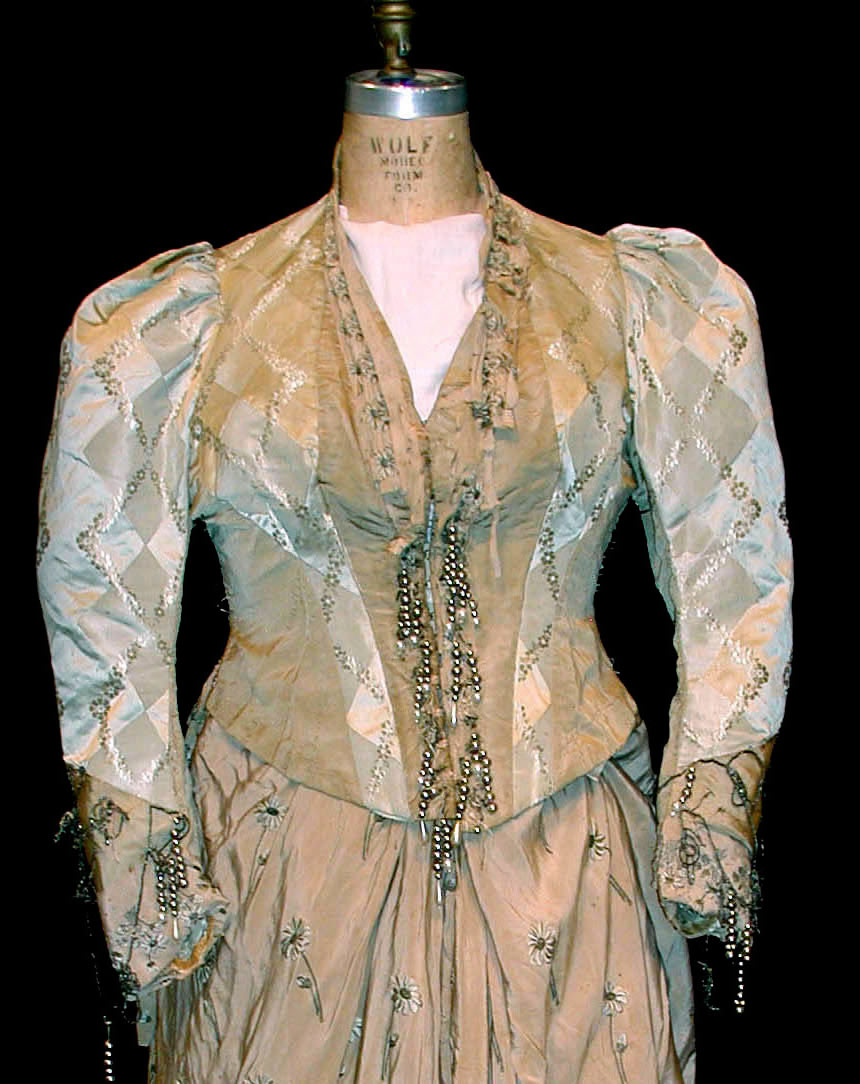 |
 |
This sage green late bustle ensemble, c. 1889, is composed of a fitted, boned bodice and a skirt with a back train. The bodice is made up of six vertical panels per side and a collar piece. The two-piece sleeve consists of an oversleeve and an undersleeve, with an extremely full cap gathered into the armscye. It appears that the bodice has been significantly altered at least once, as evidenced by the fact that this garment has buttonholes worked into the proper right side of the center front opening. These were later covered by trim, and hooks and eyes were stitched to the bodice to serve as the new closures. When this change to the closures was made, the neckline was also altered. The original incarnation of the garment extended an additional 5 4/5" to fill in the décolletage, though it only buttoned up an additional inch from the current finished neckline edge. As there are no buttonholes in the other 4 3/4", this original neckline may have been turned back in the form of revers. The turned back fabric can be seen in the interior of the garment in illustration 3 below.
Figure 3: Alteration toOriginal Neckline |
 |
As the collar is made up in the same faille seen in this modified center front panel, the collar could have been cut down from its original shape to accommodate this deeper neckline. Trim is found around the center front opening and collar matching that found on the sleeve hems, bodice hem, and skirt; it may also have been in a different configuration before this neckline alteration took place. There are also areas of scarring and thread remains on the side front, side seams, and side back where darts have been taken through all layers of the finished bodice in a quick and dirty fashion and later picked back out. These alterations can be seen in Figures 4a and 5b below.
Figure 4a: Temporary DartsInserted and Removed |
Figure 4b: Temporary DartsInserted and Removed |
 |
 |
The bodice shaping was created through a combination of seaming, darting, boning, and interfacing, in addition to the corset, bustle cage, and petticoat that would have been worn underneath. The seams running along the sides of the back and front allow the pieces to create the extreme contours of the desired hourglass shape, coming in at the waist below a full bust and splaying out over top of the bustle cage and petticoat at the hem. There is also a seam down center back to allow the back of the bodice to scoop in at the small of the back before curving outward to rest on top of the bustle foundation. In the front of the garment, the side front seams continue into the front side front piece as darts, providing a closer fit below the bust.
Though the collar in its current incarnation could have been patterned in one with the center front bodice panel, it is instead a separate piece whose join with the body is hidden by trim. It is 2" at its tallest point in the center back, and extends 2" beyond the shoulder seam. The back hemline extends 6" below the waistline and 3" at center front.
All of the seams have been boned from the hem to below the apex and shoulder blade lines. In all, there are eleven 3/8" whalebones around the bodice, as well as one ½” steel bone on the proper left side of the center front opening. The bones at the side seams stop 1 1/2" from the bottom of the armscye. The bones have been placed in cotton twill tape casings which have been stitched to the seam allowances of each seam and wrapped around the rounded top edges of the bones. The stitching holding the bones in place goes through the bones themselves. This in addition to the translucent brown appearance of the bones indicates they are genuine baleine. One of the bones had come loose from its casing, and these characteristics can be seen in Figure 5 below. The bone in center front has been finished with metal ends, wrapped in silk, and cross stitched in place. This bone may have been added when the neckline and closures were changed. It can be seen in Figure 6 below.
Figure 5: Baleine Boning |
Figure 6: Steel Boning |
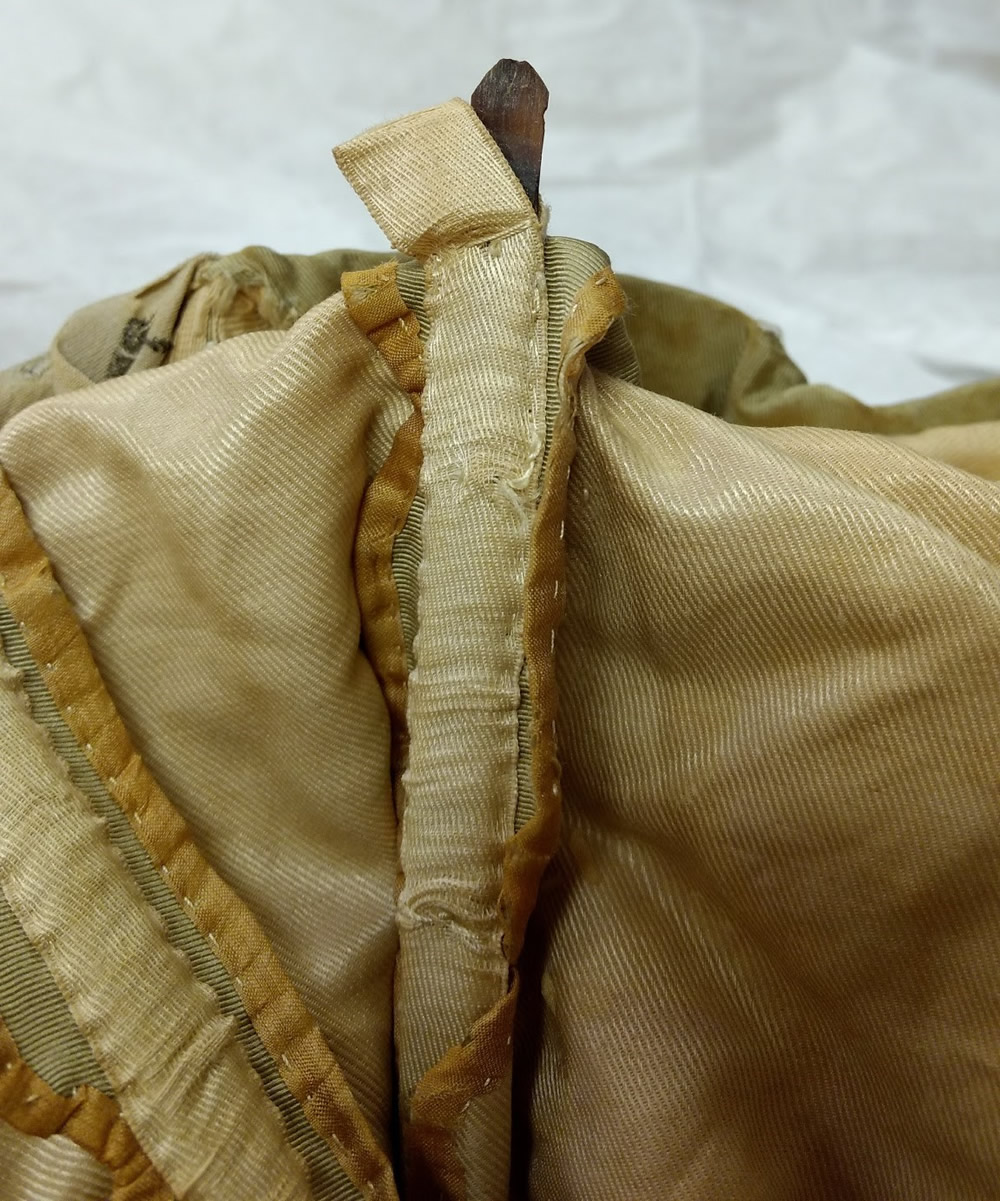 |
 |
The sleeves have been flatlined to a tissue taffeta that is shattering throughout the sleeve. The bodice has been flatlined to a medium weight polished twill weave cotton; this fabric was also used to line the collar. The collar is interfaced with a stiff woven fabric cut on the bias, similar to the French canvas used in the collar of men’s tailored jackets. This structure can be seen in Figure 7.
Figure 7: Collar Interfacing |
 |
The bodice is primarily constructed from two coordinating fashion fabrics. One is an army green faille. The other is a damask in a cooler sage color. The pattern formed by the jacquard weave in this damask creates diamonds in alternating rib and satin weaves with floral designs in long satin floats forming offset diamonds running over top of the rib and satin weave areas. The overall appearance creates a delicate argyle pattern. This can be seen in Figure 8 below, and in the full back image in Figure 2 above. Though the fabric could be interpreted as reversible, the satin floats on the floral elements and in the more lustrous diamonds are a plain weave on the back.
Figure 8: Diamond Pattern |
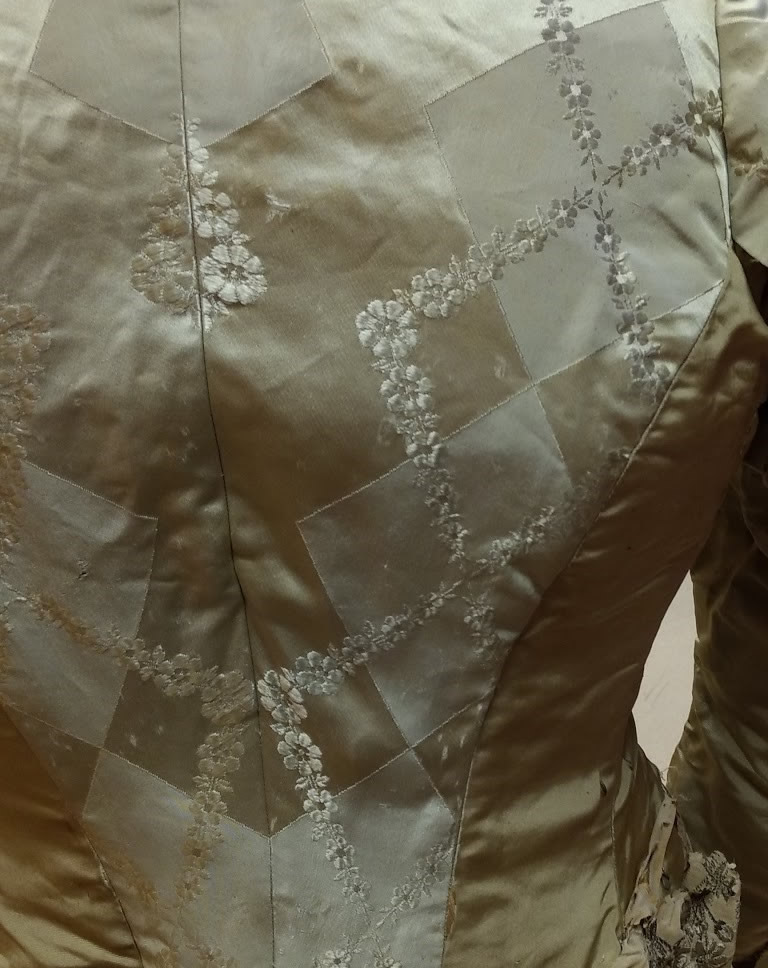 |
The faille makes up the center front and the sides of the bodice, as well as the undersleeve and the forepart of the oversleeve. The damask makes up the side front, the center back, and the majority of the oversleeve. The forepart of the oversleeve has a section of faille applied on top, beneath which the damask continues for only 3”. The entire sleeve hem is trimmed with a 3” wide band of embroidered fabric that has been top applied with a running stitch by hand.. The sleeve hem is finished with tape similar to hug snug that has been hand stitched with 1/16" stitches a scant 1/8" from the edges, and the seam allowance is bound. The faille of neither the oversleeve nor the undersleeve continue to the finished hem line, leaving only the flatlining remaining turned up on itself and bound. The cut edges of the faille are unfinished, but are hidden under the band of trim. The interior of the sleeve hem can be seen in Figure 9 below.
Figure 9: InteriorSleeveFinishing |
Figure 10: GrosgrainWaist Tape |
 |
 |
The seam allowance, which in not a consistent width throughout but rather varies from 1" at the shoulder seams to 1/2" at the center back waist, is bound with bias strips of silk. This is a different fabric from the tissue taffeta lining the sleeves, as the sleeve flatlining is cream-colored while this binding has yellowed significantly. It may have been manufactured binding. The cut edges of the binding are left raw, and it is attached with running 1/16" hand stitches. The binding finishes at 3/16" and can also be seen in the sleeves. At the true waist of the garment, there is a 1 1/4" grosgrain ribbon that closes with one hook and eye at center front. It is flossed around the back 3 bones to hold it in place. This can be seen in Figure 10 above. The waist tape is printed with a green mark that reads "O.P. Mills 18½ 28th Street, New York." Just below the waist tape, there are three closed hooks firmly stitched to the bones and imprinted "NICHOLLS."
The hem of the garment, as well as the center front closure, has been finished with a cotton tape. It has a tight twill weave and finished edges that feel similar to those cut in synthetic fabric with a hot knife. The tape has been stitched on by hand with 1/8" running stitches 1/8" from each manufactured edge of the tape. At center front a whipstitch has been used to hold the interior side of the tape to the bodice. This tape has been cut away 1 1/2" below the top of the bone on proper left. This can be seen in Figure 11 below.
Figure 11: Front Edge Finishing |
 |
The bodice is trimmed at the hem, sleeve hems, center front, and around the back of the collar with a machine-embroidered trim. This embroidery has a floral motif and includes metallic threads. It has sustained significant damage and is deteriorating. It has come off of the bodice in several locations and only the hand baste that originally held it on can be seen. In addition, there are beaded drops and a form of tinsel yarn trimming the center front and the forepart of the sleeves. The beads are plastic, and each drop varies slightly in size from another. The beads include round 3/8" satin-finish gray ones, round 1/8" shiny gray ones, round 3/8" pearl-like ones, 1/8" pearl-like round and bugle beads, and pearl-like teardrop shapes that are 3/8" around and 3/4" in length. These drops are strung on silk buttonhole twist, some strands of which remain attached to the bodice and tinsel though the beads have fallen off. The beaded trim at center front can be seen in Figure 12 below.
Figure 12: Beaded Trim |
Figure 13: Tinsel Trim |
 |
 |
Damage
Because it has sustained so much damage, it is impossible to tell how the tinsel trim was incorporated at center front. On the sleeve forepart, however, it was stitched into spiral patterns. This can be determined because there is staining in that pattern in the area, and because the tinsel is still stitched to itself in spirals in some areas even though it has come apart from the bodice. This evidence can be seen in Figure 13 above.
The bust area on both sides of the front has sustained significant damage, likely abraded by the top ridge of the corset, leaving only the yarns which are running horizontally around the bodice intact. As these are likely the stronger warp fibers, this would indicate that the flatlining was cut on the cross grain. Similar damage to the flatlining is seen at the shoulders and at the back just beneath the collar. There is extensive deep brown waxy staining in the proper right underarm, and a minimal amount of similar staining in the same area proper left. This can be seen in Figure 14 below.
Figure 14: Waxy Stain |
Figure 15: Eyes and Tabbed Trim |
 |
 |
There are several areas where the cover fabric is damaged. The faille is smiling along many of the body seams. There are two vertical tears on the back side panel as well as some red marks. These are located in an area where a dart was once hand-stitched through all layers of the finished bodice. Similar tears are seen in the side fronts and in the under arm of the sleeves. There are small areas of staining throughout. There are small holes all over, especially where the trim has come off of the garment near the hem, the foreparts of the sleeves, and on the proper left side of the neckline. 1/2" above the hem on the back proper right of the bodice, there are several different styles and sizes of eyes stitched in place, six in total. These are obscured by the tabbed embroidered trim placed at waist level, which is separating from the garment. The eyes are not present elsewhere on the hem, and significant marring of this area makes it difficult to know whether they existed along the entire hem. The eyes and tabbed trim can be seen in Figure 15 above.
Dating
This sage green ensemble represents a transition between what are typically considered disparate stylistic periods. The volume of the skirt in the rear references the third--or large--bustle period and the fullness in the sleeve caps references the hourglass period associated with the 1890s. These elements of silhouette, along with other components, suggest that the bodice dates to 1889 or 1890.
The shape and volume of the skirt is a major contributing factor when dating this ensemble. The skirt accommodates a bustle cage that is very large and shelf-like. This type was seen in what is sometimes referred to as the third bustle period, inasmuch as it followed both the first appearance of bustles and the subsequent cuirasse styles of the 1870s and early 1880s. These changes in skirts can be seen in fashion plates of the day, and the large low bustle begins to take hold in the mid-1880s, according to Stella Blum on page 178 of her book Victorian Fashions and Costumes from Harper's Bazar. Jean Jean Hunnisett indicates that the bustle was at its "most aggressive" in 1886 on page 116 of Period Costume from Stage and Screen. Though by the end of the 1880s those on the cutting edge of fashion and dress reformers were eschewing the bustle, there is evidence that it was still in use by some women into the first few years of the 1890s, as observed by Alison Gernsheim on page 77 of Victorian and Edwardian Fashion: A Photographic Survey. The element that is most influential in dating this garment is the sleeve shape. The voluminous leg-o-mutton sleeves that would come to define the daytime silhouette of the 1890s were not seen in the mid-1880s. They begin to be seen just at the turn of the decade, such as in fashion plates in Harper’s Bazaar from 1889 and 1890, reproduced in Victorian Fashions and Costumes from Harper's Bazar on pages 216 to 223. The research on which Janet Arnold bases her book, Englishwomen's Dresses and Their Construction C. 1860-1940 concerning the period also indicates that the sleeve changes at this time, and a bodice with extremely similar style lines is shown dating to c. 1890 on page 11 of her book. Taking all these factors into account, it is likely that this ensemble dates to 1889 or 1890.
© Emily Plonski, 2017


